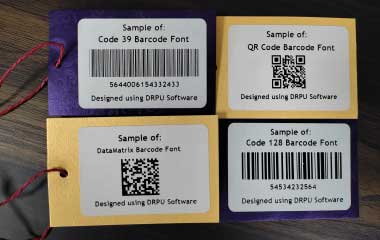Types of Barcode Symbologies used in Industrial Settings
There are several types of barcode symbologies commonly used in industrial settings, including the Code 39, the Code 128, and the Data Matrix.

-
The Code 39 is a type of barcode that encodes alphanumeric characters, including letters, numbers, and symbols. It is commonly used in industrial settings because it can be easily customized to include specific information such as lot numbers, part numbers, and serial numbers.
-
The Code 128 is another type of barcode commonly used in industrial settings. It can encode a wide range of characters, including letters, numbers, and symbols, and it is designed to be highly flexible and customizable. Code 128 barcodes can also include checksum digits to ensure accuracy and help prevent errors during scanning.
-
The Data Matrix is a 2D barcode that can encode large amounts of data in a small space. It is often used in industrial settings to track small parts and components because it can be printed at a small size and still be easily scanned with a barcode scanner.
In contrast, barcodes used in other industries, such as healthcare and retail, may include additional information such as patient information, medication dosage, and pricing information. These barcodes may also need to be more durable and resistant to environmental conditions to ensure accurate scanning throughout the product's life cycle.
The type of barcode symbology used in industrial settings will depend on the specific needs of the organization and the type of information that needs to be tracked and monitored.
Types of Barcode Symbologies used in Industrial Automation
There are several types of barcode symbologies commonly used in industrial automation, including the Code 128, the QR Code, and the Data Matrix.
-
01 Code 128
The Code 128 is a widely used barcode symbology in industrial automation. It can encode a wide range of characters, including letters, number, and symbols, and it is designed to be highly flexible and editable. Code 128 barcodes can also include checksum digits to ensure accuracy.
-
02 QR Code
The Quick Response (QR) Code is a two-dimensional barcode that can encode a large amount of data in a very small space. It is commonly used in industrial automation because it can be easily read by camera-based scanners and is resistant to damage as well as contamination.
-
03 Data Matrix
The Data Matrix is another two-dimensional barcode that can encode a large amount of data in a small space. It is often used in industrial automation to track small parts and components because it can be printed at a small size and still be easily scanned with a barcode scanner.
These barcode symbologies differ from other barcode systems in terms of their ability to encode large amounts of data and their suitability for use in industrial automation.
Barcodes used in industrial automation are typically used to track parts, components, and other items throughout the manufacturing and production process.
They may also include information such as production dates, expiration dates, and other data that is important for tracking and managing inventory.
Automation barcodes refer to the use of barcode systems in manufacturing and industrial settings to automate processes such as inventory management, quality control, and product tracking. The regulatory requirements for automation barcodes can vary depending on the industry and the specific application.
In the United States, the standards for automation barcodes are often set by industry organizations and government agencies such as the American National Standards Institute (ANSI) and the International Organization for Standardization (ISO). ANSI has established standards for barcode symbologies and barcode data content, while ISO has established standards for barcode verification and quality.
In the European Union, the European Committee for Standardization (CEN) and the European Committee for Electrotechnical Standardization (CENELEC) are responsible for setting standards for automation barcodes. These organizations have established standards for barcode symbologies and barcode data content, as well as for the use of barcode technology in specific industries such as healthcare and logistics.
Other countries and regions may have their own regulatory requirements for automation barcodes, which may be set by government agencies or industry organizations. These requirements are typically designed to ensure the safe and efficient use of barcode technology in industrial settings, and may include standards for barcode quality, scanning devices, and system integration.
Types of Barcode Symbologies used in Industrial Applications
In industrial applications, several types of barcode symbologies are commonly used to identify and track products, parts, and materials throughout the manufacturing and distribution process. Here are some of the most popular industrial barcode symbologies and their distinguishing features:
-
 Code 39
Code 39
Code 39 is a variable-length, alphanumeric barcode that can encode uppercase letters, numbers, and several special characters. It is commonly used in manufacturing and distribution operations to label products and parts, as well as to track inventory.
-
Code 128
Code 128 is a high-density, variable-length barcode that can encode both alphanumeric and special characters. It is widely used in logistics and supply chain management to track products and shipments, as well as in healthcare for patient identification and medication tracking.
-
Data Matrix
Data Matrix is a two-dimensional (2D) barcode that can store large amounts of data in a small space. It is commonly used in manufacturing and aerospace industries to track parts and components, as well as in healthcare for labeling medical devices and supplies.
-
QR Code
QR Code is another 2D barcode that can store large amounts of data, including URLs, text, and contact information. It is widely used in marketing and advertising, as well as in transportation and logistics for package tracking.
Compared to other barcode systems, industrial barcode symbologies are often designed to withstand harsh environmental conditions and to be easily read by barcode scanners, even from a distance or at an angle. They also tend to encode more data than consumer-oriented barcodes, and may be used for a wider range of applications, including inventory management, quality control, and asset tracking.